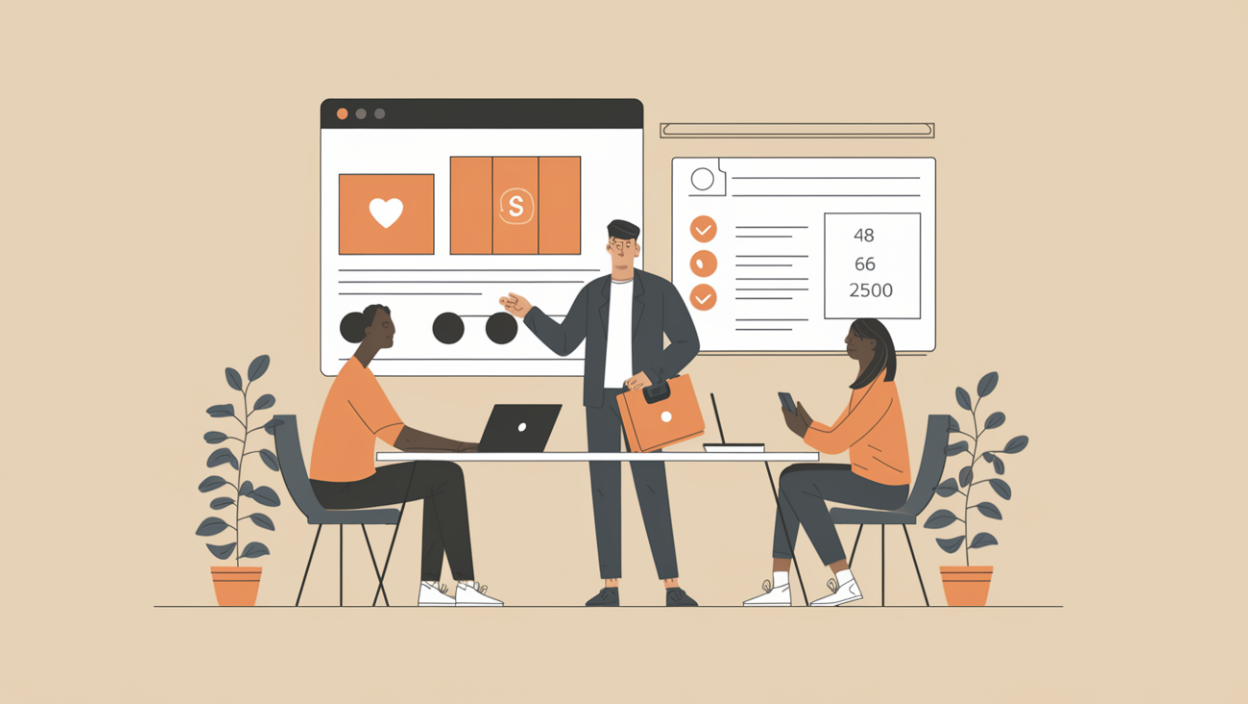
A/B Testing for E-Commerce: The Secret Weapon for Higher Conversions
Let’s be real—guesswork isn’t a strategy. If you’re relying on gut feelings to tweak your Shopify store, you’re basically throwing darts blindfolded and hoping for a bullseye. That’s why A/B testing for e-commerce is an absolute game-changer.
Why A/B Testing Should Be Every Shopify Owner’s Best Friend:
✅ Takes the guesswork out of Shopify conversion optimization.
✅ Helps you test real customer behavior instead of assumptions.
✅ Increases revenue by refining what actually works.
Fact: Companies that implement A/B testing see a 20%–30% improvement in conversion rates.
What You’ll Learn in This Guide:
✅ What A/B testing for e-commerce is & why it’s crucial for Shopify success.
✅ The key elements every Shopify store should test.
✅ How to run high-converting split tests with data-backed insights.
✅ How Cirius Marketing can help Shopify brands crush their A/B testing game.
By the time you’re done reading, you won’t just know what A/B testing is—you’ll be obsessed with optimizing your Shopify store like a CRO pro.

What is A/B Testing for E-Commerce & How Does It Work?
A/B Testing: The Science of Higher Conversions, Without the Guesswork
Imagine running a Shopify store where every decision is backed by data—not gut feelings, random opinions, or that one time your cousin told you a red “Buy Now” button works better.
That’s the magic of A/B testing for e-commerce.
What A/B Testing Actually Is:
✅ A/B testing (also called split testing) is comparing two versions of a webpage, ad, or email to see which one performs better.
✅ It helps you measure real customer behavior instead of making assumptions.
✅ It’s like a head-to-head battle where only the highest-converting version survives.
Fact: Brands that A/B test their Shopify pages regularly see up to 30% more conversions than those that don’t.
1. The Science Behind A/B Testing for E-Commerce
The Mistake: Thinking A/B testing is just about button colors (Spoiler: It’s so much more).
How A/B Testing Works in E-Commerce:
✅ Step 1: Create two versions (A & B) of a webpage, email, or ad.
✅ Step 2: Split traffic between the two versions (50% of visitors see A, 50% see B).
✅ Step 3: Track which version gets more clicks, conversions, or sales.
✅ Step 4: Implement the winning variation and repeat.
Example: A Shopify skincare brand tested two different product descriptions—one focused on ingredients, the other on benefits. The benefit-driven page boosted conversions by 24%.
2. Real-World A/B Testing Success Stories from Shopify Brands
Fact: Companies that test their landing pages see up to 223% higher engagement rates.
E-Commerce Brands Winning with A/B Testing:
✅ A fashion retailer tested lifestyle images vs. studio shots—lifestyle images converted 35% better.
✅ A Shopify electronics store tested free shipping vs. a 10% discount—free shipping led to 18% more sales.
✅ A fitness brand tested two different CTAs on checkout pages—”Get Yours Now” outperformed “Buy Now” by 14%.
Bottom Line: The smallest changes can lead to huge revenue gains.

Key Elements You Should Be A/B Testing for E-Commerce Success
What Should You A/B Test? (Hint: Almost Everything That Drives Sales)
If you’re only testing button colors, you’re missing the bigger picture.
A/B testing for e-commerce is about testing the right things—the ones that move the needle on conversions.
What to A/B Test First? (High-Impact Shopify Tests)
✅ Landing pages – Headlines, images, CTA placement.
✅ Product pages – Descriptions, layouts, and checkout buttons.
✅ Checkout flow – Payment methods, trust signals, and form length.
✅ Pricing & promotions – Discount percentages, free shipping offers.
Fact: Brands that systematically A/B test their pages see an average 20-30% revenue increase.
1. Landing Pages – Testing Headlines, Images, and CTA Placement for Higher Conversions
The Mistake: Assuming a one-size-fits-all landing page will convert all visitors.
What to Test on Landing Pages:
✅ Headline variations—Benefit-driven vs. feature-driven.
✅ Images—Lifestyle vs. product-focused visuals.
✅ CTA button color & placement—Above the fold vs. below the fold.
Example: A Shopify fashion store tested “Limited-Time Sale” vs. “Today Only: 30% Off” as the main headline. The second version increased conversions by 21%.
2. Product Pages – Optimizing Descriptions, Layouts, and Buttons for Better Engagement
Fact: 87% of online shoppers say clear, compelling product descriptions influence their purchase decisions.
What to Test on Product Pages:
✅ Short vs. long descriptions—Does your audience prefer details or quick highlights?
✅ Star ratings and reviews—Placing them higher vs. keeping them below the fold.
✅ CTA wording—“Add to Cart” vs. “Buy Now.”
Example: A Shopify home decor brand tested a product page layout with vs. without user-generated photos—the version with UGC increased conversions by 18%.
3. Checkout Flow – Reducing Cart Abandonment with a More Seamless User Experience
The Mistake: Thinking your checkout page doesn’t need testing (Hint: It does).
What to Test in Checkout Flow:
✅ Guest checkout vs. mandatory account creation.
✅ Single-page vs. multi-step checkout process.
✅ Trust signals (security badges, testimonials) near the payment button.
Example: A Shopify electronics store tested a single-page vs. multi-step checkout—the single-page version reduced cart abandonment by 14%.
4. Pricing & Promotions – Experimenting with Discounts & Free Shipping Offers
💡 Fact: 93% of customers will buy more if free shipping is offered.
What to Test in Pricing & Promotions:
✅ Flat discounts (e.g., 20% off) vs. dollar-based discounts ($10 off).
✅ Discounts vs. free shipping—Which boosts conversions more?
✅ Tiered pricing—“Buy 2, Get 10% Off” vs. “Buy 3, Get 15% Off.”
Example: A Shopify pet supply store tested “20% off your first order” vs. “Free shipping on your first order”—free shipping won by a 17% increase in conversions.

How to Run an Effective A/B Test for E-Commerce
Running an A/B Test That Actually Increases Conversions (No Guesswork Required)
So you’re ready to A/B test your Shopify store. Awesome.
But before you start changing everything at once—slow down. 🚦
A/B testing for e-commerce only works when you follow a structured process.
How to Run an A/B Test That Gets Real Results:
✅ Step 1: Set a clear goal (More clicks? More sales? Higher AOV?)
✅ Step 2: Create a hypothesis (What change do you think will work best?)
✅ Step 3: Use an A/B testing tool (Google Optimize, Shopify Experiments, VWO).
✅ Step 4: Run the test long enough to collect meaningful data.
✅ Step 5: Analyze the results and implement the winner.
Fact: A/B tests should run at least two weeks to collect enough data for a valid result.
1. Setting Clear Goals – Identify What You Want to Improve
The Mistake: Running an A/B test without knowing what success looks like.
How to Set the Right Goals:
✅ Do you want to increase conversions? Click-through rates? AOV?
✅ Define a key metric to track (e.g., checkout completion rate).
✅ Ensure you have enough traffic to generate statistically significant results.
Example: A Shopify fashion brand tested two CTA buttons (“Shop Now” vs. “Get 10% Off”)—the discount CTA boosted click-throughs by 22%.
2. Creating Hypotheses – Predicting Which Changes Will Drive Better Results
Fact: A solid A/B testing hypothesis is based on data—not just guesses.
How to Create a Data-Driven Hypothesis:
✅ Look at heatmaps, analytics, and customer behavior before testing.
✅ Example hypothesis: “If we move customer reviews higher on product pages, conversions will increase.”
✅ Test meaningful changes that actually impact revenue.
Example: A Shopify skincare brand tested putting testimonials above the product description—it increased conversions by 19%.
3. Using A/B Testing Tools – Shopify’s Built-in Features, Google Optimize, VWO, Optimizely
The Mistake: Running tests manually instead of using the right tools.
Best A/B Testing Tools for Shopify Stores:
✅ Shopify Experiments (Built-in for Shopify Plus users).
✅ Google Optimize (Free and powerful for testing site elements).
✅ Optimizely & VWO (Advanced tools for A/B and multivariate testing).
Example: A Shopify electronics brand used Google Optimize to test checkout page layouts—simplifying the design reduced cart abandonment by 15%.
4. Running Tests Long Enough – Why Collecting Enough Data Matters
Fact: Ending a test too soon can lead to misleading conclusions.
How Long Should an A/B Test Run?
✅ At least 2 weeks, but ideally until 100+ conversions per variation.
✅ Use statistical significance calculators to ensure accurate results.
✅ Don’t panic if results fluctuate early—wait for stable trends.
Example: A Shopify home decor store saw no improvement in week one of an A/B test—but after three weeks, conversions increased by 12%.

Best Practices for High-Converting A/B Testing for E-Commerce
A/B Testing Like a Pro: The Secret to Winning More Conversions
A/B testing for e-commerce isn’t just about running tests—it’s about running the right tests the right way.
Follow these best practices to ensure your Shopify split tests actually increase revenue.
The Golden Rules of A/B Testing for Shopify Conversion Optimization:
✅ Test one variable at a time—no “Frankenstein” experiments.
✅ Segment your traffic—different audiences behave differently.
✅ Analyze results correctly—don’t just pick the higher number.
Fact: Brands that follow A/B testing best practices see 2-3X higher ROI than those that don’t.
1. Testing One Variable at a Time – Avoiding Multiple Changes That Skew Results
The Mistake: Changing multiple things at once (button color, headline, and layout) and then not knowing what actually worked.
How to Keep A/B Testing Clean & Actionable:
✅ Only test one element per experiment (headline, image, CTA placement, etc.).
✅ If you want to test multiple things, use sequential A/B tests.
✅ Avoid multivariate tests unless you have massive traffic.
Example: A Shopify outdoor gear brand tested just the product image on a landing page—lifestyle photo vs. close-up shot. The lifestyle image boosted conversions by 17%.
2. Segmenting Traffic – Testing Based on Audience Behavior & Demographics
Fact: Visitors from different sources may respond to the same test differently.
How to Optimize A/B Tests with Audience Segmentation:
✅ Test separately for desktop vs. mobile users.
✅ Segment first-time visitors vs. returning customers.
✅ Compare organic traffic vs. paid ad traffic results.
Example: A Shopify fashion store ran an A/B test on their homepage CTA—“Shop New Arrivals” vs. “Get 10% Off Your First Order.”
- First-time visitors preferred the discount (13% conversion increase).
- Returning visitors responded better to “Shop New Arrivals” (+11% conversion rate).
3. Analyzing Results Correctly – How to Interpret A/B Test Data for Action
The Mistake: Ending a test as soon as you see a slight improvement.
How to Read A/B Testing Results Like a Pro:
✅ Use statistical significance calculators (aim for 95% confidence).
✅ Look at secondary metrics (bounce rate, session duration, AOV).
✅ Test different traffic segments before rolling out site-wide changes.
Example: A Shopify beauty brand thought a new checkout button color was winning—but after testing for three weeks, they found the difference wasn’t statistically significant.
4. Using AI to Automate & Optimize A/B Testing for Maximum ROI
Fact: AI-powered A/B testing tools can predict winners faster and adjust in real-time.
How AI Can Supercharge A/B Testing for Shopify:
✅ AI tools analyze visitor behavior and suggest optimizations.
✅ Dynamic A/B testing adapts elements in real-time.
✅ Predictive analytics help forecast long-term conversion trends.
Example: A Shopify fitness brand used AI-driven A/B testing to optimize product recommendations—leading to a 24% increase in upsell conversions.

Common A/B Testing Mistakes & How to Avoid Them
A/B Testing Mistakes That Kill Conversions (And How to Fix Them)
Not all A/B tests lead to higher conversions—in fact, some can waste your time, confuse your data, or even hurt sales.
If you’re making these mistakes, you’re throwing away valuable insights.
The Most Common A/B Testing Pitfalls (and How to Fix Them):
✅ Stopping tests too early—patience is key.
✅ Testing insignificant changes—focus on high-impact elements.
✅ Ignoring mobile vs. desktop differences—different audiences behave differently.
✅ Not factoring in customer feedback—numbers don’t always tell the full story.
Fact: 60% of e-commerce brands don’t run A/B tests long enough to get accurate results.
1. Stopping Tests Too Early Before Collecting Enough Data
The Mistake: Seeing a 10% increase after two days and assuming it’s a winner.
Why You Need to Be Patient:
✅ Run tests for at least two weeks to account for variations in traffic.
✅ Wait until the test reaches statistical significance (95% confidence).
✅ Use tools like Google Optimize or Optimizely to track validity.
Example: A Shopify electronics brand thought an A/B test was winning after three days—but when they let it run for two weeks, the results evened out, proving no real impact.
2. Testing Minor Changes That Don’t Impact Conversions
Fact: Big changes = big results. Testing button colors? Probably a waste of time.
What to Focus on Instead:
✅ Headlines, product descriptions, and images (first impression elements).
✅ CTA placement and wording (where and how you ask customers to buy).
✅ Checkout flow optimizations (reducing friction at the final step).
✅ Example: A Shopify apparel brand tested “Buy Now” vs. “Get Yours Today” in their CTA—it made no difference. When they tested a free shipping offer vs. a discount, conversions increased by 19%.
3. Not Considering Mobile vs. Desktop Differences
The Mistake: Assuming what works on desktop will also work on mobile.
Why Mobile A/B Testing Matters:
✅ Mobile users scroll differently—test image placement & CTA positioning.
✅ Navigation should be seamless—test simplified menus & mobile-friendly buttons.
✅ Checkout needs to be fast—test Apple Pay, Google Pay, and one-click options.
Example: A Shopify beauty brand tested a mobile-friendly one-page checkout vs. a multi-step checkout—the one-page version reduced cart abandonment by 21%.
4. Ignoring Qualitative Feedback from Customers
Fact: Customer feedback is just as important as analytics.
How to Combine Data with Real Customer Insights:
✅ Use heatmaps to see where visitors get stuck.
✅ Check surveys and reviews to understand pain points.
✅ Run session recordings to see actual user behavior.
Example: A Shopify pet brand saw a low conversion rate despite a high-ranking product page. Customer surveys revealed that buyers wanted more detailed sizing info—fixing this increased sales by 17%.

How Cirius Marketing Can Help You Optimize Conversions Through A/B Testing
Want Higher Conversions? Let’s Take the Guesswork Out of Your Shopify Store
Let’s be real—A/B testing for e-commerce can feel like a full-time job.
If you’re spending hours setting up split tests, analyzing confusing data, and second-guessing results, you’re not focusing on what really matters—scaling your Shopify business.
That’s where Cirius Marketing comes in.
How We Help Shopify Stores Run Data-Driven A/B Tests That Boost Revenue:
✅ Custom A/B testing strategy designed for your unique audience.
✅ Full-service testing for landing pages, product pages, and checkout optimization.
✅ Deep data analysis & CRO (Conversion Rate Optimization) recommendations.
Fact: Shopify brands that work with A/B testing experts see a 25-40% increase in conversions within months.
1. Custom Shopify A/B Testing Strategy & Execution
The Problem: Random testing with no clear goals wastes time and resources.
How Cirius Marketing Fixes It:
✅ We identify key areas that are hurting your conversions.
✅ We design data-backed tests that focus on high-impact improvements.
✅ We ensure every test is statistically valid before making changes.
Example: A Shopify electronics brand saw a 31% increase in revenue after we optimized their checkout flow through A/B testing.
2. Full-Service Split Testing for Landing Pages, Checkout, and Product Pages
Fact: Even small improvements in these areas can lead to thousands in extra revenue.
What We A/B Test for Shopify Brands:
✅ Landing Pages: Testing headlines, CTA placement, and product visuals.
✅ Product Pages: Optimizing descriptions, trust signals, and social proof.
✅ Checkout Process: Reducing friction, enabling guest checkout, and optimizing for mobile users.
✅ Example: A Shopify beauty brand tested adding user-generated photos vs. no UGC—sales increased by 22% after implementing customer images.
3. Data Analysis & CRO Recommendations to Maximize Revenue
The Problem: Running A/B tests is one thing—understanding the data is another.
How We Turn A/B Test Results Into More Sales:
✅ We break down test data into clear, actionable insights.
✅ We help you scale winning variations across your entire store.
✅ We continuously test and optimize to maximize ROI.
Example: A Shopify apparel brand tested free shipping vs. 10% off—the free shipping offer won by 17%, so we applied it store-wide and boosted overall sales.
Your Shopify Store Needs A/B Testing—Are You Ready to Optimize?
By now, you understand that A/B testing for e-commerce isn’t just a nice-to-have—it’s the key to increasing conversions, sales, and profitability.
If you’re not testing and optimizing, you’re leaving money on the table.
What Happens When You Implement A/B Testing?
✅ More conversions—because every page is optimized for sales.
✅ Higher revenue—because you’re continuously improving what works.
✅ Better customer experience—because data-driven decisions beat guesswork.
Fact: Shopify brands that implement A/B testing see an average revenue increase of 30% in 6 months.
The question is: Will your store be one of them?
That’s where Cirius Marketing comes in.
How to Get a High-Converting Shopify Store with Cirius Marketing
We take the guesswork out of A/B testing and create a custom strategy that fits your store’s audience, products, and goals.
What You Get When You Work With Us:
✅ A fully customized A/B testing strategy tailored to your brand.
✅ Automated workflows that continuously optimize your Shopify store.
✅ Data-driven insights to improve product pages, checkout flows, and CTAs.
✅ Hands-on support from e-commerce CRO experts.
Example: A Shopify fitness brand boosted conversions by 41% in 90 days after implementing Cirius Marketing’s A/B testing strategy.
Book a Free Shopify A/B Testing Strategy Consultation Today
Here’s how to get started:
1️⃣ Click below to book a free strategy session.
2️⃣ We analyze your current conversion performance & identify areas for improvement.
3️⃣ You get a fully optimized, high-converting Shopify A/B testing plan.
Book Your Free Shopify A/B Testing Strategy Consultation Now
✔ No guesswork. No wasted tests. Just results.
